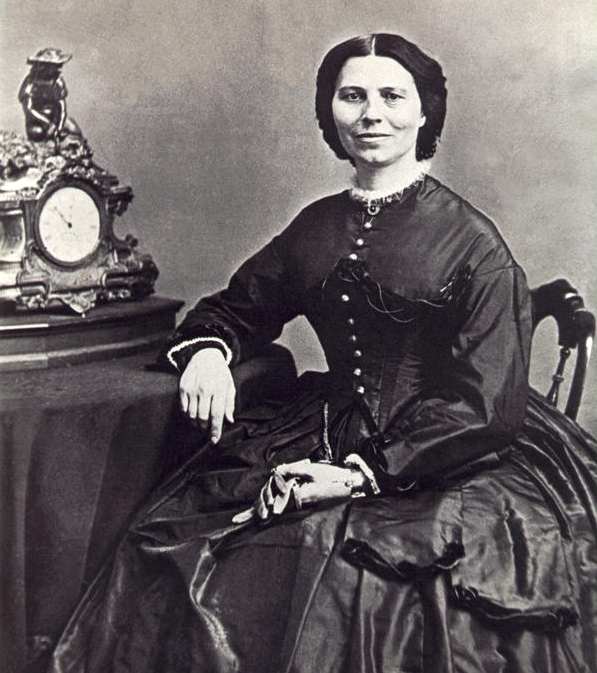“God, Home, and Country”
Founded on October 11 1890, the Daughters of the American Revolution was one of many hereditary patriotic groups who traced their roots to the foundation of the United States. When the Sons of the American Revolution banned the entrance of women, the DAR was formed.

Ellen Walworth, one of the co-founders.
These women wanted to “perpetuate the memory and spirit of the men and women who achieved American Independence,” through this new society. It grew quickly, and soon became not only a prominent heritage group, but a renowned women’s society. It established a literal blood bond between women, and the “white lineal societies” like the D.A.R. re-imagined their connection to the country as their claim to “true Americanism.” Its first scandal came when a member, Flora Darling, openly fought their regulations regarding bloodlines. She argued that those who descended from “Mother of a Patriot” were of degenerate stock, and those admitted through “collateral descent,” darkened the purity of the blood.
As a result, in 1894 the annual congress agreed and strict linear descent from a male relative was made a requirement for membership. Other membership requirements included upstanding moral character, proper documentation, good disposition, and any other qualities deemed “acceptable.” This excluded poor women who could not obtain official documentation due to either their socioeconomic status, or that of their revolutionary ancestor. It also left out those they saw as not “acceptable,” like Black women, Jewish women, and Native American women. This led to a special sense of superiority related to the claim of revolutionary blood, and created a group of upper class white women. These women had the luxury of being able to define their heritage as truly American, descended from the “heroic white patriots” of the revolution.

Clara Barton, a member of the DAR.
The notion of “Republican Motherhood,” was particularly popular with the group, and they praised the women of the revolution for the sacrifices they made for the greater good of the country. Mothers of the revolution were not afraid to send their sons off to war and fiercely defend their homes, and the DAR saw itself as the inheritor of that legacy in a modern context – educating the youth on patriotism and sacrifice for country and staunchly supported the military.
They created the “Children of the American Revolution” in order to promote education, lobbied for Flag Day, funded the installation of historic markers for battles and events of the American Revolution, paid for grave markers for soldiers, and supported English and history classes for new immigrants to help integrate them into American society. Part of this included handing out manuals to help with different aspects of American culture and donating clothes to new immigrants to help keep women busy. At the same time, they actively argued against immigration and allowing immigrants to begin the “clouding of the purity cup”of Anglo-Saxon blood. The reasoning behind donating cloth to make clothing was to keep them busy which meant “less time for riotous discontent, formerly apparent in ceaseless fighting,” that they considered immigrants to be prone to.
This conservative rhetoric coupled with an active role in patriotic and charitable efforts made the DAR appealing on a massive scale, and by 1900, the membership had reached over 30,000 women. By 1929, it had 165,000 members and 2,275 active chapters. Their efforts were dedicated to education, historic preservation, and patriotism. They partially funded schools for those “children of pure Anglo-Saxon strain tucked away in the remote hills of the Southland,” and “Americanization Schools” for immigrant children. Scholarship funds were given to the states to award to any student regardless of race. By the 1930s the DAR eventually amassed property valued at over a million including Continental Hall, administrative buildings, and Constitution Hall, and they were hoping to eventually open the largest genealogical resource center in the United States.
Further Reading:
The Daughters of the American Revolution History Exhibit
Sources:
Carolyn Strange. “Sisterhood of Blood: The Will to Descend and the Formation of the Daughters of the American Revolution.” Journal of Women’s History 26, no. 3 (2014): 105-128. https://muse.jhu.edu/ (accessed September 30, 2016).
Carol Medlicott, “One Social Milieu, Paradoxical Responses: A Geographical Re-Examination of the Ku Klux Klan and the Daughters of the American Revolution in the Early Twentieth Century,” in Spaces of Hate: Geographies of Discrimination and Intolerance in the U.S.A., ed. Colin Flint (Routledge Press, 2003) 21-48.
Glen Jeansonne, Women of the Far Right: The Mothers’ Movement and World War II (Chicago: University of Chicago, 1996).
